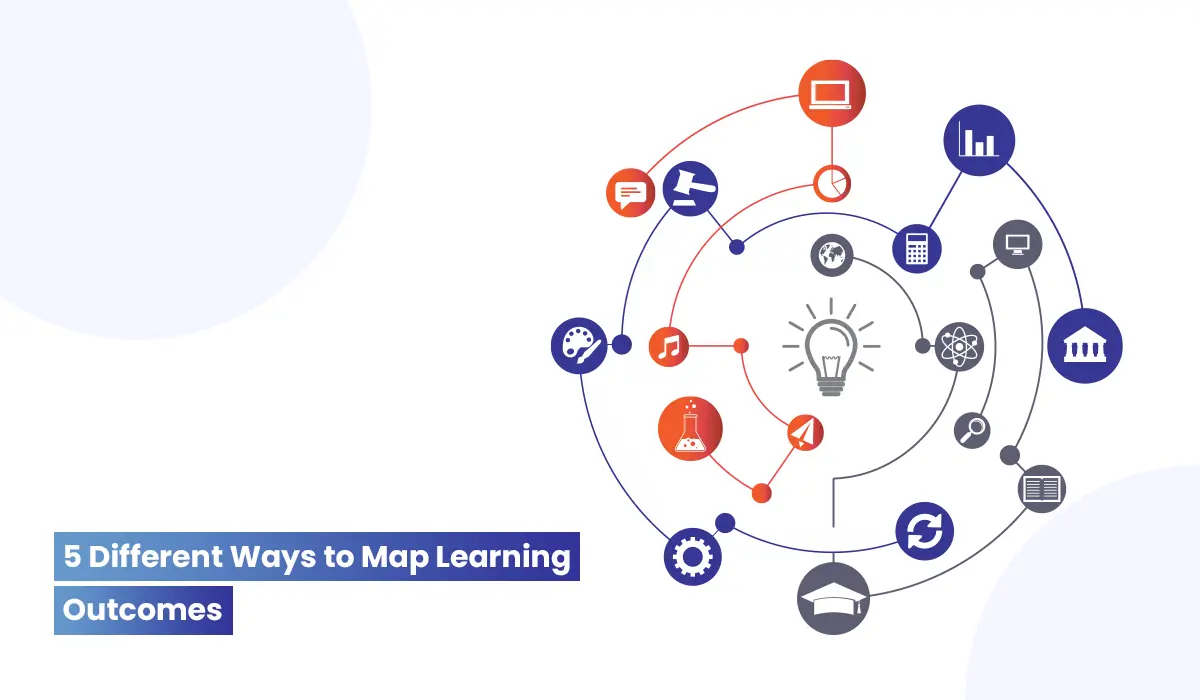When it comes to mapping learning outcomes, the secret lies in various ways it is done. The rising demand in today’s institutions has left the departments to ruminate on course content, curricular goals, a regular and systematic review process of the goals, how courses support the attainment of the goals, and how these goals are assessed. This is absolutely where mapping creeps in. With the advent of outcome-based education, mapping has become a more crucial concept.
The curriculum mapping process happens differently in different institutions. We tried interacting with a few educational institutions to find out their ways of mapping learning outcomes. We inferred that most of the institutions use up to a maximum of 5 levels of mapping when trying to achieve a comprehensive outcome. This blog aims to discuss those 5 levels of mapping. In addition, we’ve tried drawing references to the traditional mapping process which is in contrast to the current one.
The traditional process of curriculum mapping
Being the most common approach, curriculum mapping was entirely done by faculty, but often without discussion with the student affairs or without the students themselves. Hence, the result obtained rarely represented the fullness of a degree or the student learning experience. The following were the three traditionally used approaches to curriculum mapping.
- Mapping learning outcomes started with a compilation of responses got as a result of sending an excel spreadsheet/template electronically to the faculty or staff.
- Completion of the entire mapping by the program head who does it in isolation to be submitted to the assessment management system. There could be less or no conversation with other faculties during this process.
- A meeting point where faculty comes together to identify the alignment of the course and to address various learning outcomes. Usually, this step is entailed by a planned examination.
The current scenario
Mapping is nothing but a visual approach that analyzes the underlying framework of a program. Unlike the traditional way, the overview mapping learning outcomes can be achieved in many ways—the creation of charts, tables, and graphs. Mapping determines how the current requirements of your program support the achievement of your learning outcome goals. A much simpler version of a curriculum map is built on a two-dimensional matrix, with the learning outcomes arrayed across the top (as the x-axis) and courses listed down on the left side (as y-axis).
| Learning outcomes 1 | Learning outcomes 2 | Learning outcomes 3 | |
| Course 1 | x | x | |
| Course 2 | x | x | |
| Course 3 | x |
5 levels of Mapping
While there is strictly no right or wrong to handle the mapping process, we understood that each of the approaches below might have strengths and weaknesses of its own. The five levels of mapping learning outcomes are as follow:
- PO-Course mapping
- CO-PO mapping
- Assessments - CO mapping
- Syllabus - CO mapping
- Questions - CO mapping
Level 1: PO-COURSE MAPPING
This first and foremost step of Learning Outcome is that it should be mapped with Program outcomes. Program Outcomes which were earlier referred to as Graduate Attributes is all about what you expect from a graduate in his 4 years of graduation. Compliable with Bloom’s Taxonomy, this level of mapping lets the Instructor set up threshold value alongside the program learning.

Level 2: CO - PO MAPPING
Aligning program level outcomes with course-level outcomes is the second level of mapping. This level of outcomes mapping focuses on student learning and it allows faculty to create a visual map of a program. It is also the exact place to explore how students are meeting program-level outcomes at the course level.
Level 3: ASSESSMENTS - CO MAPPING
This level of mapping facilitates the alignment of various Assessments with the Courses Outcomes. The following visual represents what will the students know and be able to do as a result of his course at the course-level. If in case the course outcome relates to a campus-wide learning outcome, they get featured too. In that case, what are the ways used to assess the outcome? Is it by writing a report that you score a rubric or by a presentation? What was the total student performance on the assessment? Was he able to achieve the desired percentage levels? Lastly, as an instructor what did the instructor learn from assessing students which altered his way of teaching?
Level 4 of Mapping: Syllabus - CO mapping
This is the main in the whole of mapping levels. This shows how the entire syllabus gets mapped with the Courses in the given course time.
Level 5: QUESTIONS - CO MAPPING
It is at this level that the students develop an insight into becoming powerful questioners. An authentic inquiry learning with a visual summary on a topic is mapped with the courses. Bloom's various levels are catered to here.
These five levels of mapping articulate how the curriculum and learning goals match together. As a next step, gathering evidence of student learning follows, which involves determining assessment methods and identifying the measures.
Benefits of mapping learning outcomes
Mapping learning outcomes can result in many benefits. Here’s a list of them.
- It identifies how the required courses add to the achievement of program outcomes
- Expands the student achievement in achieving program outcomes
- Works on reflection by revealing gaps in the curriculum and propagates remedial classes
- The course instructors become fully aware of other courses in which students achieve similar outcomes and can plan their syllabi accordingly. Thus reinforcing the outcomes, helping in skill/knowledge development, and avoiding overlap
- Helps to determine the course prerequisites and program requirements based on how the outcomes fit together
- It shows the logic and overall design of a program and captures the relevance of its courses
Want to contribute?
We welcome thought leaders to share ideas and write for our blog.
Become a Guest Author →

